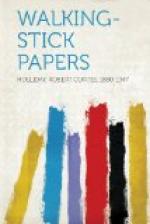Our distinguished grandfathers carried canes, frequently handsome gold-headed ones, especially if they were ministers. Bishops, or “Presiding Elders;” when, in those mellow times, it was the custom for a congregation to present its minister with a gold-headed cane duly inscribed. Our fathers of some consequence carried canes of a gentlemanly pattern, often ones with ivory handles. Though in the days when those of us now sometime grown were small one had to have arrived at the dignity of at least middle-age before it was seemly for one to carry a cane. In England, however, and particularly at Eton, it has long been a common practice for small aristocrats to affect canes.
The dandies, fops, exquisites, and beaux of picturesque and courtly ages were, of course, very partial to canes, and sometimes wore them attached to the wrist by a thong. It has been the custom of the Surgeon of the King of England to carry a “Gold Headed Cane.” This cane has been handed down to the various incumbents of this office since the days of Dr. John Radcliffe, who was the first holder of the cane. It has been used for two hundred years or more by the greatest physicians and surgeons in the world, who succeeded to it. “The Gold Headed Cane” was adorned by a cross-bar at the top instead of a knob. The fact is explained by Munk, in that Radcliffe, the first owner, was a rule unto himself and possibly preferred this device as a mark of distinction beyond the knob used by physicians in general. Men of genius now and then have found in their choice of a cane an opportunity for the play of their eccentricity, such a celebrated cane being the tall wand of Whistler. Among the relics of great men preserved in museums for the inspiration of the people canes generally are to be found. We have all looked upon the cane of George Washington at Mount Vernon and the walking-stick of Carlyle in Cheyne Walk. And is each not eloquent of the man who cherished it?
Freak canes are displayed here and there by persons of a pleasantly bizarre turn of mind: canes encased in the hide of an elephant’s tail, canes that have been intricately carven by some Robinson Crusoe, or canes of various other such species of curiosity. There is a veteran New York journalist who will be glad to show any student of canes one which he prizes highly that was made from the limb of a tree upon which a friend of his was hanged. In our age of handy inventions a type of cane is manufactured in combination with an umbrella.
Canes are among the useful properties of the theatre. He would be a decidedly incomplete villain who did not carry a cane. Imaginative literature is rich in canes. Who ever heard of a fairy godmother without a cane? Who with any feeling for terror has not been startled by the tap, tap of the cane of old Pew in “Treasure Island”? There is an awe and a pathos in canes, too, for they are the light to blind men. And the romance of




